Freeze-Drying Microencapsulation of Hop Extract: Effect of Carrier Composition on Physical, Techno-Functional, and Stability Properties
Abstract
1. Introduction
2. Materials and Methods
2.1. Materials
2.2. Samples Preparation
2.2.1. Production of Concentrated Hop Ethanolic Extract (ExC)
2.2.2. Freeze-Drying Microencapsulation of Hop Extract
2.3. Storage Stability Tests
2.4. Characterization of Concentrated Hop Extract (ExC)
2.4.1. Total Phenolic Content (TPC), Antioxidant Capacity by ABTS and FRAP Assays
2.4.2. α-Acids and β-Acids Assay
2.5. Physical and Physico-Chemical Characterization of Encapsulated Hop Extracts
2.5.1. Water Activity, Moisture Content, and Solubility
2.5.2. Flow Properties
2.5.3. Colour and Colouring Power
2.5.4. Sorption Isotherm
2.5.5. Thermal Analysis
2.5.6. Microstructure Analysis
2.6. Chemical Characterization of Encapsulated Hop Extracts
2.6.1. Total Phenolic Content and Antioxidant Capacity of Hop Powder by FRAP and ABTS Assays
2.6.2. α-Acids and β-Acids Assay
2.7. Encapsulation Efficiency and Yield of Total Phenolic Content
2.8. Statistical Analysis
3. Results
3.1. Characterization of Concentrated Hop Extract (ExC)
3.2. Physicochemical Characterization of the Encapsulated Hop Extracts
3.2.1. Water Content, Water Activity, and Solubility
3.2.2. Bulk Density, Tapped Density, Flowability, and Cohesiveness
3.2.3. Colour and Colouring Properties
3.2.4. Sorption Isotherms
3.2.5. Thermal Properties
3.2.6. Morphology
3.3. Load Yield, Encapsulation Efficiency, Bitter Acid Content, and Antioxidant Capacity of Encapsulated Hop Extracts
3.4. Storage Stability of Microencapsulated Powders
3.5. Effect of Microencapsulation on the Retention of Hop Antioxidant Compounds and Properties
4. Conclusions
Supplementary Materials
Author Contributions
Funding
Institutional Review Board Statement
Informed Consent Statement
Data Availability Statement
Acknowledgments
Conflicts of Interest
References
- Moir, M.; Moir, M.; Courage, S.; Limited, B. Hops—A Millennium Review. J. Am. Soc. Brew. Chem. 2018, 58, 131–146. [Google Scholar] [CrossRef]
- Carbone, K.; Macchioni, V.; Petrella, G.; Cicero, D.O. Exploring the Potential of Microwaves and Ultrasounds in the Green Extraction of Bioactive Compounds from Humulus lupulus for the Food and Pharmaceutical Industry. Ind. Crops Prod. 2020, 156, 112888. [Google Scholar] [CrossRef]
- Hrnčič, M.K.; Španinger, E.; Košir, I.J.; Knez, Ž.; Bren, U. Hop Compounds: Extraction Techniques, Chemical Analyses, Antioxidative, Antimicrobial, and Anticarcinogenic Effects. Nutrients 2019, 11, 257. [Google Scholar] [CrossRef] [PubMed]
- Bocquet, L.; Sahpaz, S.; Rivière, C. An Overview of the Antimicrobial Properties of Hop. In Natural Antimicrobial Agents; Mérillon, J.M., Rivière, C., Eds.; Series Sustainable Development and Biodiversity; Springer International Publishing AG: Cham, Switzerland, 2018; Volume 19, pp. 31–54. [Google Scholar]
- Karabín, M.; Hudcová, T.; Jelínek, L.; Dostálek, P. Biologically Active Compounds from Hops and Prospects for Their Use. Compr. Rev. Food Sci. Food Saf. 2016, 15, 542–567. [Google Scholar] [CrossRef]
- Liu, Y.; Gu, X.H.; Tang, J.; Liu, K. Antioxidant Activities of Hops (Humulus lupulus) and Their Products. J. Am. Soc. Brew. Chem. 2007, 65, 116–121. [Google Scholar] [CrossRef]
- Kontek, B.; Jedrejek, D.; Oleszek, W.; Olas, B. Antiradical and Antioxidant Activity In Vitro of Hops-Derived Extracts Rich in Bitter Acids and Xanthohumol. Ind. Crops Prod. 2021, 161, 113208. [Google Scholar] [CrossRef]
- Sanz, V.; Torres, M.D.; López Vilariño, J.M.; Domínguez, H. What Is New on the Hop Extraction? Trends Food Sci. Technol. 2019, 93, 12–22. [Google Scholar] [CrossRef]
- Inui, T.; Okumura, K.; Matsui, H.; Hosoya, T.; Kumazawa, S. Effect of Harvest Time on Some In Vitro Functional Properties of Hop Polyphenols. Food Chem. 2017, 225, 69–76. [Google Scholar] [CrossRef] [PubMed]
- Cory, H.; Passarelli, S.; Szeto, J.; Tamez, M.; Mattei, J. The Role of Polyphenols in Human Health and Food Systems: A Mini-Review. Front. Nutr. 2018, 5, 87. [Google Scholar] [CrossRef] [PubMed]
- Fraga, C.G.; Croft, K.D.; Kennedy, D.O.; Tomás-Barberán, F.A. The Effects of Polyphenols and Other Bioactives on Human Health. Food Funct. 2019, 10, 514–528. [Google Scholar] [CrossRef]
- Olšovská, J.; Boštíková, V.; Dušek, M.; Jandovská, V.; Bogdanová, K.; Čermák, P.; Boštík, P.; Mikyska, A.; Kolář, M. Humulus lupulus L. (Hops)—A Valuable Source of Compounds with Bioactive Effects for Future Therapies. Mil. Med. Sci. Lett. 2016, 85, 19–30. [Google Scholar] [CrossRef]
- Santarelli, V.; Neri, L.; Carbone, K.; Macchioni, V.; Pittia, P. Use of Conventional and Innovative Technologies for the Production of Food Grade Hop Extracts: Focus on Bioactive Compounds and Antioxidant Activity. Plants 2022, 11, 41. [Google Scholar] [CrossRef] [PubMed]
- Laine, P.; Kylli, P.; Heinonen, M.; Jouppila, K. Storage Stability of Microencapsulated Cloudberry (Rubus chamaemorus) Phenolics. J. Agric. Food Chem. 2008, 56, 11251–11261. [Google Scholar] [CrossRef] [PubMed]
- Vinceković, M.; Viskić, M.; Jurić, S.; Giacometti, J.; Bursać Kovačević, D.; Putnik, P.; Donsì, F.; Barba, F.J.; Režek Jambrak, A. Innovative Technologies for Encapsulation of Mediterranean Plants Extracts. Trends Food Sci. Technol. 2017, 69, 1–12. [Google Scholar] [CrossRef]
- Labuschagne, P. Impact of Wall Material Physicochemical Characteristics on the Stability of Encapsulated Phytochemicals: A Review. Food Res. Int. 2018, 107, 227–247. [Google Scholar] [CrossRef] [PubMed]
- Archaina, D.; Vasile, F.; Jiménez-Guzmán, J.; Alamilla-Beltrán, L.; Schebor, C. Physical and Functional Properties of Roselle (Hibiscus sabdariffa L.) Extract Spray Dried with Maltodextrin-Gum Arabic Mixtures. J. Food Process. Preserv. 2019, 43, e14065. [Google Scholar] [CrossRef]
- Tolun, A.; Altintas, Z.; Artik, N. Microencapsulation of Grape Polyphenols Using Maltodextrin and Gum Arabic as Two Alternative Coating Materials: Development and Characterization. J. Biotechnol. 2016, 239, 23–33. [Google Scholar] [CrossRef]
- Krishnaiah, D.; Sarbatly, R.; Nithyanandam, R. Microencapsulation of Morinda citrifolia L. Extract by Spray-Drying. Chem. Eng. Res. Des. 2012, 90, 622–632. [Google Scholar] [CrossRef]
- Leonida, M.D.; Belbekhouche, S.; Benzecry, A.; Peddineni, M.; Suria, A.; Carbonnier, B. Antibacterial Hop Extracts Encapsulated in Nanochitosan Matrices. Int. J. Biol. Macromol. 2018, 120, 1335–1343. [Google Scholar] [CrossRef]
- González-Ortega, R.; Faieta, M.; Di Mattia, C.D.; Valbonetti, L.; Pittia, P. Microencapsulation of Olive Leaf Extract by Freeze-Drying: Effect of Carrier Composition on Process Efficiency and Technological Properties of the Powders. J. Food Eng. 2020, 285, 110089. [Google Scholar] [CrossRef]
- Pudziuvelyte, L.; Marksa, M.; Sosnowska, K.; Winnicka, K.; Morkuniene, R.; Bernatoniene, J. Freeze-Drying Technique for Microencapsulation of Elsholtzia Ciliata Ethanolic Extract Using Different Coating Materials. Molecules 2020, 25, 2237. [Google Scholar] [CrossRef]
- Benzie, I.F.F.; Strain, J.J. Ferric Reducing/Antioxidant Power Assay: Direct Measure of Total Antioxidant Activity of Biological Fluids and Modified Version for Simultaneous Measurement of Total Antioxidant Power and Ascorbic Acid Concentration. Methods Enzymol. 1999, 299, 15–27. [Google Scholar]
- Ravichai, K.; Muangrat, R. Effect of Different Coating Materials on Freeze—Drying Encapsulation of Bioactive Compounds from Fermented Tea Leaf Wastewater. J. Food Process. Preserv. 2019, 43, e14145. [Google Scholar] [CrossRef]
- Rafaella, Y.; Santos, R.; Nogueira, J.P.; Narain, N. Microencapsulation of Extracts of Bioactive Compounds Obtained from Acerola (Malpighia emarginata DC) Pulp and Residue by Spray and Freeze Drying: Chemical, Morphological and Chemometric Characterization. Food Chem. 2018, 254, 281–291. [Google Scholar]
- Caliskan, G.; Dirim, S.N. The Effect of Different Drying Processes and the Amounts of Maltodextrin Addition on the Powder Properties of Sumac Extract Powders. Powder Technol. 2016, 287, 308–314. [Google Scholar] [CrossRef]
- Santarelli, V.; Neri, L.; Moscetti, R.; Daniela, C.; Mattia, D.; Sacchetti, G.; Massantini, R.; Pittia, P. Combined Use of Blanching and Vacuum Impregnation with Trehalose and Green Tea Extract as Pre-Treatment to Improve the Quality and Stability of Frozen Carrots. Food Bioproc. Tech. 2021, 287, 308–314. [Google Scholar] [CrossRef]
- Mohd Nawi, N.; Muhamad, I.I.; Mohd Marsin, A. The Physicochemical Properties of Microwave-Assisted Encapsulated Anthocyanins from Ipomoea Batatas as Affected by Different Wall Materials. Food Sci. Nutr. 2015, 3, 91–99. [Google Scholar] [CrossRef]
- Blahovec, J.; Yanniotis, S. Gab Generalized Equation for Sorption Phenomena. Food Bioprocess Technol. 2008, 1, 82–90. [Google Scholar] [CrossRef]
- Sarabandi, K.; Jafari, S.M.; Mahoonak, A.S.; Mohammadi, A. Application of Gum Arabic and Maltodextrin for Encapsulation of Eggplant Peel Extract as a Natural Antioxidant and Color Source. Int. J. Biol. Macromol. 2019, 140, 59–68. [Google Scholar] [CrossRef]
- Lyu, J.; Ryu, J.; Seo, K.S.; Kang, K.Y.; Park, S.H.; Ha, T.H.; Ahn, J.W.; Kang, S.Y. Comparative Study on Phenolic Compounds and Antioxidant Activities of Hop (Humulus lupulus L.) Strobile Extracts. Plants 2022, 11, 135. [Google Scholar] [CrossRef]
- Wu, C.N.; Sun, L.C.; Chu, Y.L.; Yu, R.C.; Hsieh, C.W.; Hsu, H.Y.; Hsu, F.C.; Cheng, K.C. Bioactive Compounds with Anti-Oxidative and Anti-Inflammatory Activities of Hop Extracts. Food Chem. 2020, 330, 127244. [Google Scholar] [CrossRef] [PubMed]
- Mafakheri, M.; Hamidoghli, Y. Effect of Different Extraction Solvents on Phenolic Compounds and Antioxidant Capacity of Hop Flowers (Humulus lupulus L.). Acta Hortic. 2019, 1236, 1–6. [Google Scholar] [CrossRef]
- Önder, F.C.; Ay, M.; Sarker, S.D. Comparative Study of Antioxidant Properties and Total Phenolic Content of the Extracts of Humulus lupulus L. and Quantification of Bioactive Components by LC-MS/MS and GC-MS. J. Agric. Food Chem. 2013, 61, 10498–10506. [Google Scholar] [CrossRef] [PubMed]
- Pellegrini, N.; Serafini, M.; Salvatore, S.; Del Rio, D.; Bianchi, M.; Brighenti, F. Total Antioxidant Capacity of Spices, Dried Fruits, Nuts, Pulses, Cereals and Sweets Consumed in Italy Assessed by Three Different In Vitro Assays. Mol. Nutr. Food Res. 2006, 50, 1030–1038. [Google Scholar] [CrossRef]
- Muzolf-Panek, M.; Stuper-Szablewska, K. Comprehensive Study on the Antioxidant Capacity and Phenolic Profiles of Black Seed and Other Spices and Herbs: Effect of Solvent and Time of Extraction. J. Food Meas. Charact. 2021, 15, 4561–4574. [Google Scholar] [CrossRef]
- Dadi, D.W.; Emire, S.A.; Hagos, A.D.; Eun, J.B. Physical and Functional Properties, Digestibility, and Storage Stability of Spray-and Freeze-Dried Microencapsulated Bioactive Products from Moringa Stenopetala Leaves Extract. Ind. Crops Prod. 2020, 156, 112891. [Google Scholar] [CrossRef]
- Mahdavee Khazaei, K.; Jafari, S.M.; Ghorbani, M.; Hemmati Kakhki, A. Application of Maltodextrin and Gum Arabic in Microencapsulation of Saffron Petal’s Anthocyanins and Evaluating Their Storage Stability and Color. Carbohydr. Polym. 2014, 105, 57–62. [Google Scholar] [CrossRef]
- Masuelli, M.A. Hydrodynamic Properties of Whole Arabic Gum. Am. J. Food Sci. Technol. 2013, 1, 3–9. [Google Scholar]
- Neri, L.; Pittia, P.; Bertolo, G.; Torreggiani, D.; Sacchetti, G. Influence of Water Activity and System Mobility on Peroxidase Activity in Maltodextrin Solutions. Food Biophys. 2011, 6, 281–287. [Google Scholar] [CrossRef]
- Tonon, R.V.; Brabet, C.; Hubinger, M.D. Anthocyanin Stability and Antioxidant Activity of Spray-Dried Açai (Euterpe Oleracea Mart.) Juice Produced with Different Carrier Agents. Food Res. Int. 2010, 43, 907–914. [Google Scholar] [CrossRef]
- Orlien, V.; Andersen, A.B.; Sinkko, T.; Skibsted, L.H. Hydroperoxide Formation in Rapeseed Oil Encapsulated in a Glassy Food Model as Influenced by Hydrophilic and Lipophilic Radicals. Food Chem. 2000, 68, 191–199. [Google Scholar] [CrossRef]
- Desobry, S.A.; Netto, F.M.; Labuza, T.P. Comparison of Spray-drying, Drum-drying and Freeze-drying for β-Carotene Encapsulation and Preservation. J. Food Sci. 1997, 62, 1158–1162. [Google Scholar] [CrossRef]
- Fernandes, R.V.D.B.; Borges, S.V.; Botrel, D.A. Gum Arabic/Starch/Maltodextrin/Inulin as Wall Materials on the Microencapsulation of Rosemary Essential Oil. Carbohydr. Polym. 2014, 101, 524. [Google Scholar] [CrossRef] [PubMed]
- Jinapong, N.; Suphantharika, M.; Jamnong, P. Production of Instant Soymilk Powders by Ultrafiltration, Spray Drying and Fluidized Bed Agglomeration. J. Food Eng. 2008, 84, 194–205. [Google Scholar] [CrossRef]
- Cortés-Rojas, D.F.; Souza, C.R.F.; Oliveira, W.P. Encapsulation of Eugenol Rich Clove Extract in Solid Lipid Carriers. J. Food Eng. 2014, 127, 34–42. [Google Scholar] [CrossRef]
- Barbosa, J.; Borges, S.; Amorim, M.; Pereira, M.J.; Oliveira, A.; Pintado, M.E.; Teixeira, P. Comparison of Spray Drying, Freeze Drying and Convective Hot Air Drying for the Production of a Probiotic Orange Powder. J. Funct. Foods 2015, 17, 340–351. [Google Scholar] [CrossRef]
- Mathlouthi, M.; Rogé, B. Water Vapour Sorption Isotherms and the Caking of Food Powders. Food Chem. 2003, 82, 61–71. [Google Scholar] [CrossRef]
- Romero-González, J.; Shun Ah-Hen, K.; Lemus-Mondaca, R.; Muñoz-Fariña, O. Total Phenolics, Anthocyanin Profile and Antioxidant Activity of Maqui, Aristotelia Chilensis (Mol.) Stuntz, Berries Extract in Freeze-Dried Polysaccharides Microcapsules. Food Chem. 2020, 313, 126115. [Google Scholar] [CrossRef] [PubMed]
- Navarro-Flores, M.J.; Ventura-Canseco, L.M.C.; Meza-Gordillo, R.; Ayora-Talavera, T.d.R.; Abud-Archila, M. Spray Drying Encapsulation of a Native Plant Extract Rich in Phenolic Compounds with Combinations of Maltodextrin and Non-Conventional Wall Materials. J. Food Sci. Technol. 2020, 57, 4111–4122. [Google Scholar] [CrossRef] [PubMed]
- Cruz-Molina, A.V.D.L.; Ayala Zavala, J.F.; Bernal Mercado, A.T.; Cruz Valenzuela, M.R.; González-Aguilar, G.A.; Lizardi-Mendoza, J.; Brown-Bojorquez, F.; Silva-Espinoza, B.A. Maltodextrin Encapsulation Improves Thermal and pH Stability of Green Tea Extract Catechins. J. Food Process. Preserv. 2021, 45, e15729. [Google Scholar] [CrossRef]
- Vuillemin, M.E.; Michaux, F.; Adam, A.A.; Linder, M.; Muniglia, L.; Jasniewski, J. Physicochemical Characterizations of Gum Arabic Modified with Oxidation Products of Ferulic Acid. Food Hydrocoll. 2020, 107, 105919. [Google Scholar] [CrossRef]
- Lewicki, P.P. The Applicability of the GAB Model to Food Water Sorption Isotherms. Int. J. Food Sci. 1997, 32, 553–557. [Google Scholar] [CrossRef]
- Serris, G.S.; Biliaderis, C.G. Degradation Kinetics of Beetroot Pigment Encapsulated in Polymeric Matrices. J. Sci. Food Agric. 2001, 81, 691–700. [Google Scholar] [CrossRef]
- Ramoneda, X.A.; Ponce-Cevallos, P.A.; Buera, M.d.P.; Elizalde, B.E. Degradation of β-Carotene in Amorphous Polymer Matrices. Effect of Water Sorption Properties and Physical State. J. Sci. Food Agric. 2011, 91, 2587–2593. [Google Scholar] [CrossRef]
- Nurhadi, B.; Roos, Y.H.; Maidannyk, V. Physical Properties of Maltodextrin de 10: Water Sorption, Water Plasticization and Enthalpy Relaxation. J. Food Eng. 2016, 174, 68–74. [Google Scholar] [CrossRef]
- Roos, Y.H. The glassy state. In Food Materials Science; Springer: New York, NY, USA, 2008; pp. 67–81. [Google Scholar]
- Roos, Y.H. Glass Transition Temperature and Its Relevance in Food Processing. Annu. Rev. Food Sci. Technol. 2010, 1, 469–496. [Google Scholar] [CrossRef]
- Hussain, S.A.; Hameed, A.; Nazir, Y.; Naz, T.; Wu, Y.; Suleria, H.A.R.; Song, Y. Microencapsulation and the Characterization of Polyherbal Formulation (PHF) Rich in Natural Polyphenolic Compounds. Nutrients 2018, 10, 843. [Google Scholar] [CrossRef]
- Ramírez, M.J.; Giraldo, G.I.; Orrego, C.E. Modeling and Stability of Polyphenol in Spray-Dried and Freeze-Dried Fruit Encapsulates. Powder Technol. 2015, 277, 89–96. [Google Scholar] [CrossRef]
- Che Man, Y.; Irwandi, J.; Abdullah, W. Effect of Different Types of Maltodextrin and Drying Methods on Physico-Chemical and Sensory Properties of Encapsulated Durian Flavour. J. Sci. Food Agric 1999, 79, 1075–1080. [Google Scholar] [CrossRef]
- Yadav, M.P.; Manuel Igartuburu, J.; Yan, Y.; Nothnagel, E.A. Chemical Investigation of the Structural Basis of the Emulsifying Activity of Gum Arabic. Food Hydrocoll. 2007, 21, 297–308. [Google Scholar] [CrossRef]
- Ballesteros, L.F.; Ramirez, M.J.; Orrego, C.E.; Teixeira, J.A.; Mussatto, S.I. Encapsulation of Antioxidant Phenolic Compounds Extracted from Spent Coffee Grounds by Freeze-Drying and Spray-Drying Using Different Coating Materials. Food Chem. 2017, 237, 623–631. [Google Scholar] [CrossRef] [PubMed]
- Chranioti, C.; Tzia, C. Arabic Gum Mixtures as Encapsulating Agents of Freeze-Dried Fennel Oleoresin Products. Food Bioprocess Technol. 2014, 7, 1057–1065. [Google Scholar] [CrossRef]
- Da Rosa, C.G.; Borges, C.D.; Zambiazi, R.C.; Rutz, J.K.; da Luz, S.R.; Krumreich, F.D.; Benvenutti, E.V.; Nunes, M.R. Encapsulation of the Phenolic Compounds of the Blackberry (Rubus fruticosus). LWT–Food Sci. Technol. 2014, 58, 527–533. [Google Scholar] [CrossRef]
- Burin, V.M.; Rossa, P.N.; Ferreira-Lima, N.E.; Hillmann, M.C.R.; Boirdignon-Luiz, M.T. Anthocyanins: Optimisation of Extraction from Cabernet Sauvignon Grapes, Microcapsulation and Stability in Soft Drink. Int. J. Food Sci. Technol. 2011, 46, 186–193. [Google Scholar] [CrossRef]
- Fang, Z.; Bhandari, B. Effect of Spray Drying and Storage on the Stability of Bayberry Polyphenols. Food Chem. 2011, 129, 1139–1147. [Google Scholar] [CrossRef]
- Kallithraka, S.; Salacha, M.I.; Tzourou, I. Changes in Phenolic Composition and Antioxidant Activity of White Wine during Bottle Storage: Accelerated Browning Test versus Bottle Storage. Food Chem. 2009, 113, 500–505. [Google Scholar] [CrossRef]
- Neri, L.; Faieta, M.; Di Mattia, C.; Sacchetti, G.; Mastrocola, D.; Pittia, P. Antioxidant Activity in Frozen Plant Foods: Effect of Cryoprotectants, Freezing Process and Frozen Storage. Foods 2020, 9, 1886. [Google Scholar] [CrossRef]
- Popoola, O.K.; Marnewick, J.L.; Rautenbach, F.; Ameer, F.; Iwuoha, E.I.; Hussein, A.A. Inhibition of Oxidative Stress and Skin Aging-Related Enzymes by Prenylated Chalcones and Other Flavonoids from Helichrysum Teretifolium. Molecules 2015, 20, 7143–7155. [Google Scholar] [CrossRef]
- Krofta, K.; Vrabcová, S.; Mikyška, A.; Jurková, M.; Čajka, T.; Hajšlová, J. Stability of Hop Beta Acids and Their Decomposition Products during Natural Ageing. Acta Hortic. 2013, 1010, 221–230. [Google Scholar] [CrossRef]
- Zokti, J.A.; Baharin, B.S.; Mohammed, A.S.; Abas, F. Green Tea Leaves Extract: Microencapsulation, Physicochemical and Storage Stability Study. Molecules 2016, 21, 940. [Google Scholar] [CrossRef] [PubMed]
- Jafari, S.M.; Assadpoor, E.; He, Y.; Bhandari, B. Encapsulation Efficiency of Food Flavours and Oils during Spray Drying. Dry. Technol. 2008, 26, 816–835. [Google Scholar] [CrossRef]
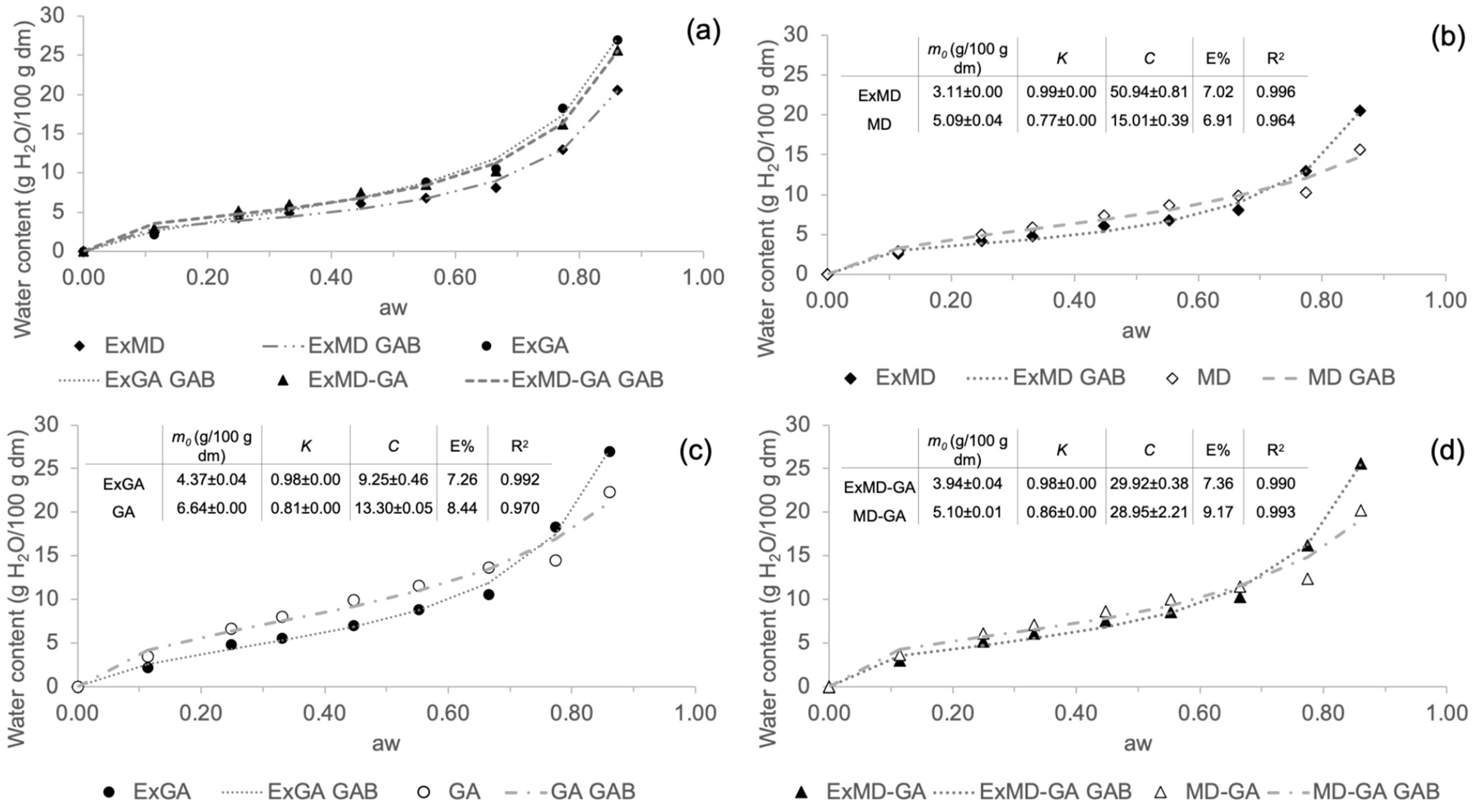
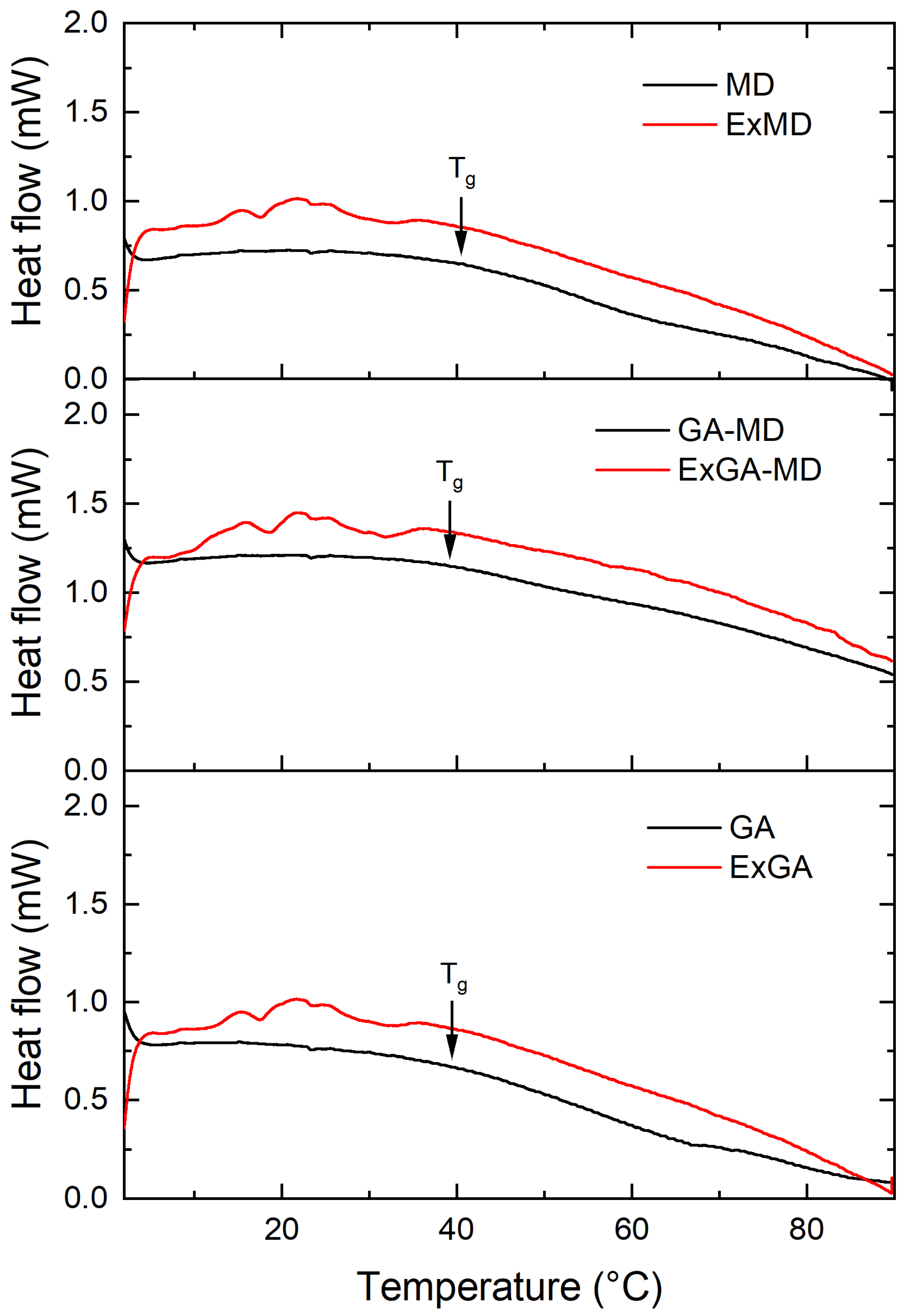

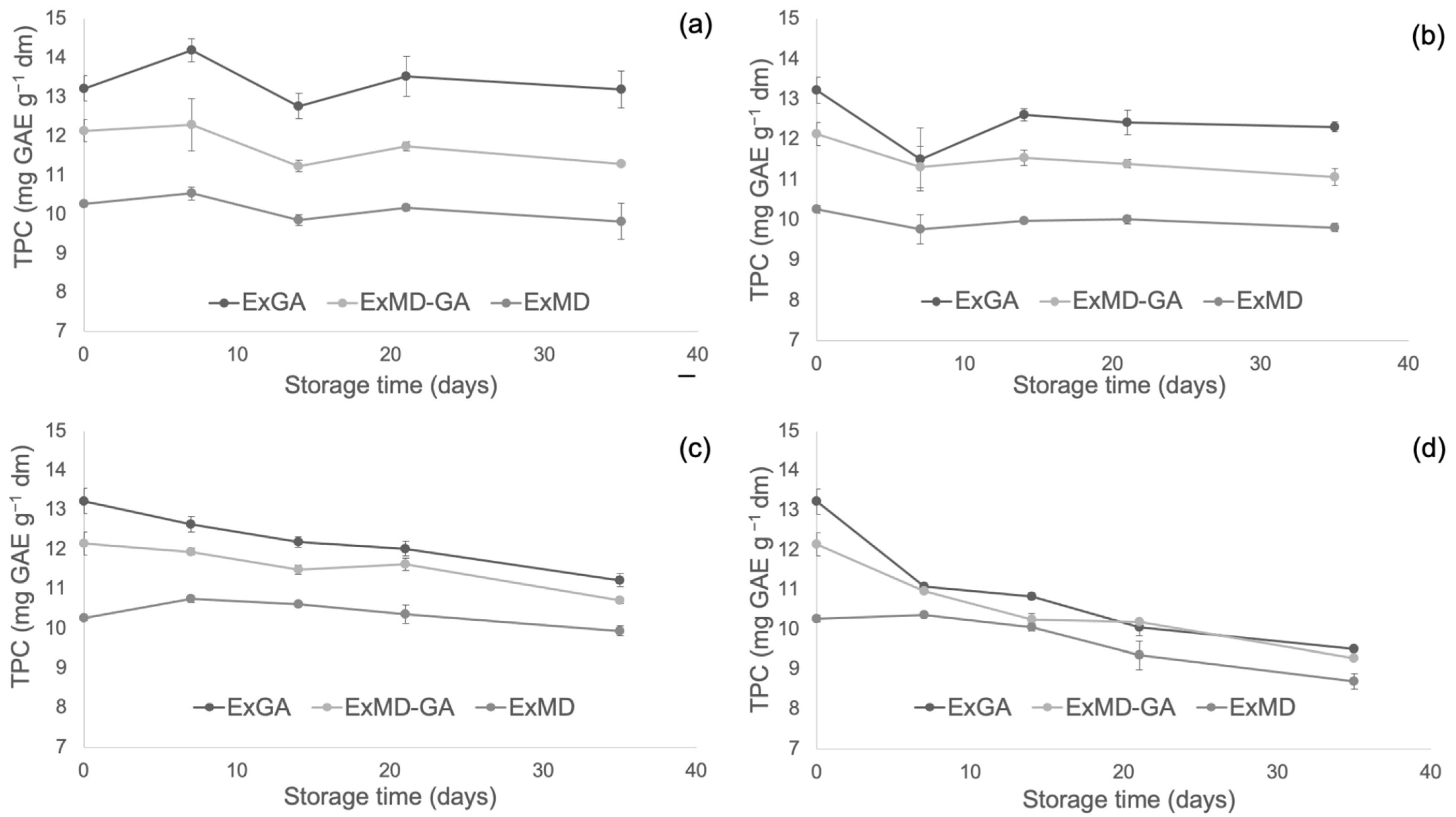
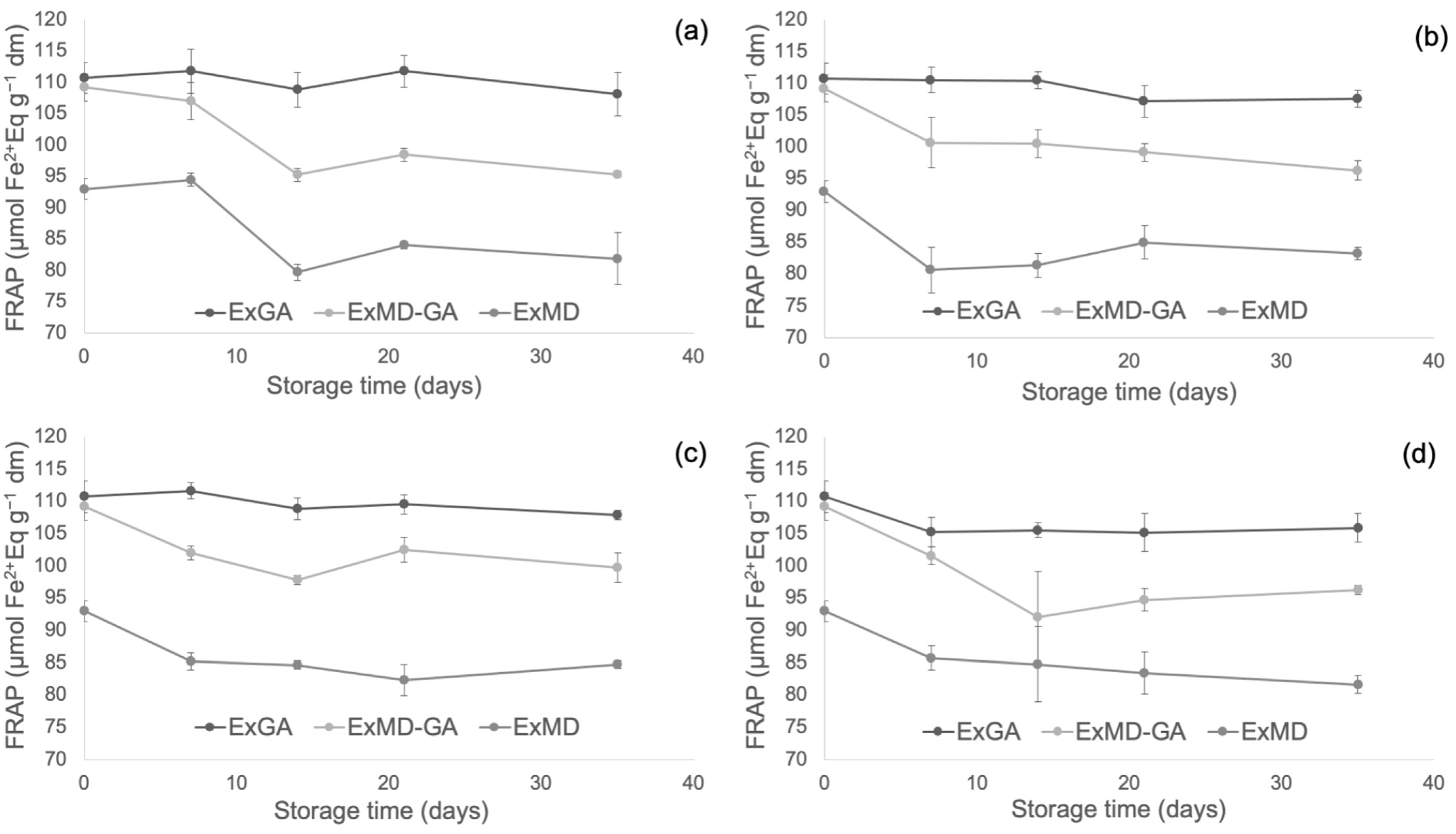
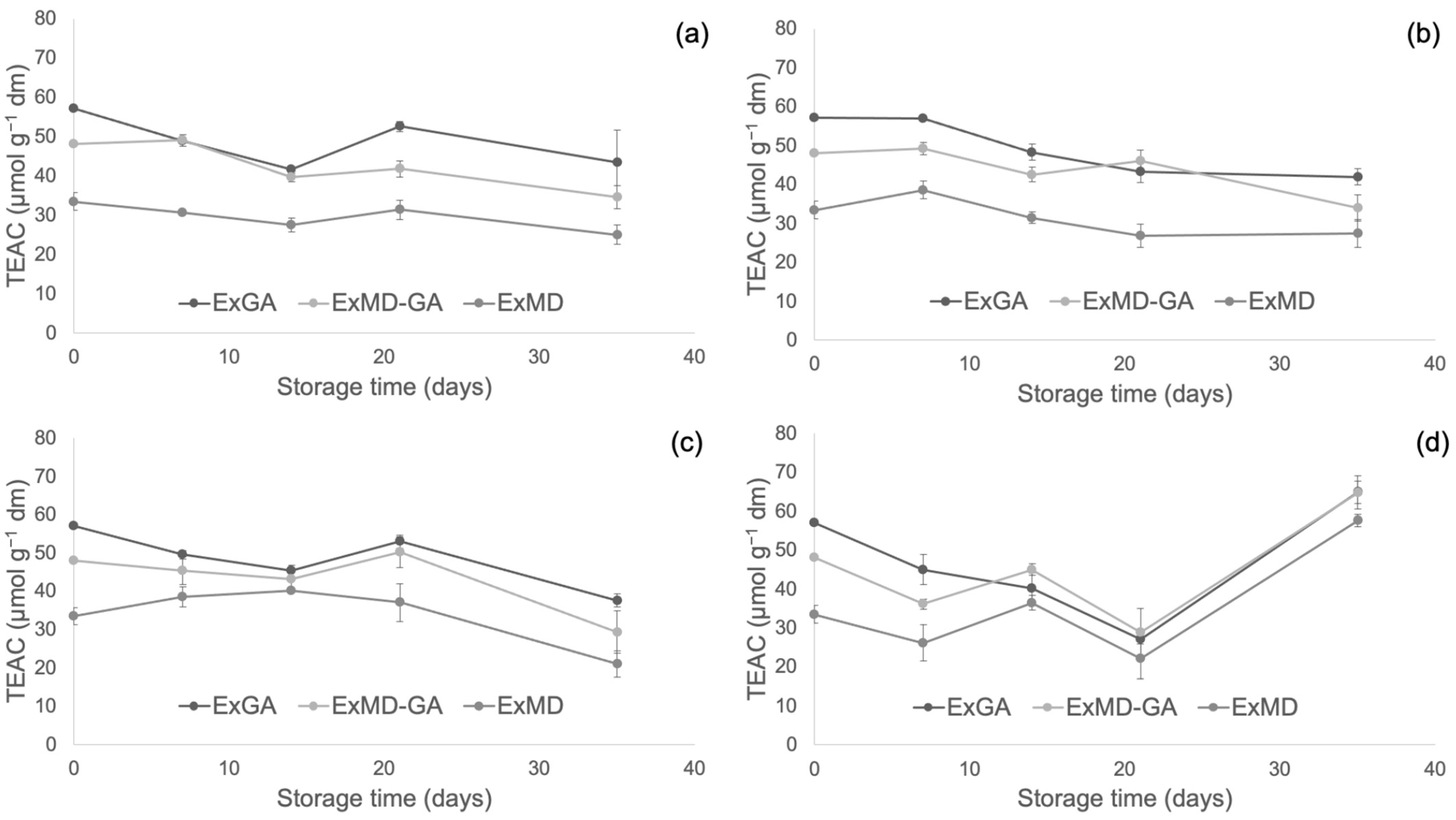

| TPC | FRAP | TEAC | α-Acids | β-Acids | |
|---|---|---|---|---|---|
| (mg GAE g −1 dm) | (µmol Fe2+Eq g −1 dm) | (µmol g−1 dm) | (% w/w) | (% w/w) | |
| ExC | 158 ± 1 (83.5 ± 0.7) | 1284 ± 53 (528 ± 28) | 757 ± 20 (401 ± 11) | 40.7 ± 0.5 | 7.53 ± 0.11 |
| Parameters | ExGA | ExMD-GA | ExMD |
|---|---|---|---|
| Water activity (aw) | 0.095 b ± 0.003 | 0.185 a ± 0.007 | 0.085 b ± 0.005 |
| Moisture content (%) | 4.07 a ± 0.64 | 5.27 a ± 0.05 | 2.19 b ± 0.28 |
| Solubility (%) | 99.10 a ± 0.01 | 99.20 a ± 0.2 | 99.10 a ± 0.01 |
| Bulk density (g/mL) | 0.236 a ± 0.011 | 0.159 c ± 0.002 | 0.172 b ± 0.005 |
| Tapped density (g/mL) | 0.395 a ± 0.004 | 0.269 c ± 0.015 | 0.322 b ± 0.009 |
| Carr Index (CI) | 38.5 a ± 2.2 | 41.5 a ± 2.3 | 45.5 a ± 3.1 |
| Hausner Ratio (HR) | 1.63 a ± 0.06 | 1.71 a ± 0.07 | 1.84 a ± 0.10 |
| Lightness (L*) 1 | 67.3 c ± 0.2 | 70.7 b ± 0.6 | 80.5 a ± 0.4 |
| (a*) 1 | −2.18 a ± 0.17 | −2.66 b ± 0.15 | −4.75 c ± 0.25 |
| (b*) 1 | 31.4 c ± 0.5 | 35.1 b ± 0.3 | 37.8 a ± 0.6 |
| Hue angle (h°) 1 | 94.5 b ± 1.1 | 94.4 b ± 0.2 | 97.1 a ± 0.4 |
| Lightness (L*) 2 | 95.7 c ± 0.0 | 96.0 b ± 0.1 | 96.3 a ± 0.0 |
| (a*) 2 | −1.48 b ± 0.02 | −1.28 a ± 0.10 | −1.44 b ± 0.02 |
| (b*) 2 | 5.34 a ± 0.11 | 4.45 b ± 0.42 | 4.49 b ± 0.08 |
| Hue angle (h°) 2 | 105.2 c ± 0.1 | 106.3 b ± 0.0 | 107.7 a ± 0.0 |
| TPC (mg GAE g−1 dm) | 13.23 a ± 0.32 | 12.15 b ± 0.29 | 10.27 c ± 0.09 |
| FRAP (µmol Fe2+ g−1 dm) | 110.8 a ± 2.4 | 109.2 a ± 2.1 | 93.0 b ± 1.7 |
| TEAC (µmol g−1 dm) | 57.83 a ± 3.78 | 48.57 b ± 2.66 | 36.63 c ± 1.90 |
| EE (%) | 73.5 b ± 1.1 | 64.3 c ± 1.4 | 78.5 a ± 2.2 |
| Y (%) | 66.6 a ± 3.1 | 62.5 a ± 3.1 | 58.1 b ± 2.4 |
| α-acids (%w/w) | 2.78 a ± 0.22 | 2.74 a ± 0.04 | 2.06 b ± 0.05 |
| β-acids (%w/w) | 0.53 a ± 0.07 | 0.28 b ± 0.04 | 0.15 c ± 0.02 |
| Storage | α-Acids (%w/w) | β-Acids (%w/w) | |||||
|---|---|---|---|---|---|---|---|
| Time (days) | Temperature (°C) | ExGA | ExMD-GA | ExMD | ExGA | ExMD-GA | ExMD |
| 0 | - | 2.78 aA ± 0.22 (-) | 2.74 aA ± 0.04 (-) | 2.06 bA ± 0.05 (-) | 0.53 aA ± 0.07 (-) | 0.28 bA ± 0.04 (-) | 0.15 cA ± 0.02 (-) |
| 35 | 5 | 2.20 aAB ± 0.25 (20.69 ± 9.08) | 1.73 abB ± 0.28 (40.05 ± 12.04) | 1.49 bB ± 0.05 (27.48 ± 2.60) | 0.20 aBC ± 0.08 (62.66 ± 14.78) | 0.11 aB ± 0.06 (70.45 ± 12.37) | 0.04 aBC ± 0.03 (57.48 ± 0.59) |
| 35 | 20 | 1.69 aB ± 0.55 (50.26 ± 6.87) | 1.62 aB ± 0.33 (45.45 ± 12.68) | 1.47 aB ± 0.05 (28.50 ± 2.49) | 0.11 aCD ± 0.10 (90.75 ± 4.44) | 0.13 aB ± 0.09 (64.48 ± 36.99) | 0.10 aAB ± 0.04 (19.10 ± 9.39) |
| 35 | 35 | 1.47 aBC ± 0.49 (37.54 ± 8.83) | 1.03 aC ± 0.01 (62.07 ± 0.49) | 1.33 aC ± 0.03 (35.18 ± 1.50) | 0.30 aB ± 0.01 (43.94 ± 1.12) | 0.05 cB ± 0.00 (82.54 ± 4.98) | 0.11 bAB ± 0.00 (29.50 ± 0.90) |
| 35 | 50 | 0.60 aC ± 0.03 (78.42 ± 1.24) | 0.59 aC ± 0.05 (77.92 ± 0.62) | 0.38 bD ± 0.02 (81.39 ± 1.07) | 0.00 bD ± 0.00 (100.00 ± 0.00) | 0.00 bB ± 0.00 (100.00 ± 0.00) | 0.02 aC ± 0.00 (87.31 ± 3.28) |
Disclaimer/Publisher’s Note: The statements, opinions and data contained in all publications are solely those of the individual author(s) and contributor(s) and not of MDPI and/or the editor(s). MDPI and/or the editor(s) disclaim responsibility for any injury to people or property resulting from any ideas, methods, instructions or products referred to in the content. |
© 2023 by the authors. Licensee MDPI, Basel, Switzerland. This article is an open access article distributed under the terms and conditions of the Creative Commons Attribution (CC BY) license (https://creativecommons.org/licenses/by/4.0/).
Share and Cite
Tatasciore, S.; Santarelli, V.; Neri, L.; González Ortega, R.; Faieta, M.; Di Mattia, C.D.; Di Michele, A.; Pittia, P. Freeze-Drying Microencapsulation of Hop Extract: Effect of Carrier Composition on Physical, Techno-Functional, and Stability Properties. Antioxidants 2023, 12, 442. https://doi.org/10.3390/antiox12020442
Tatasciore S, Santarelli V, Neri L, González Ortega R, Faieta M, Di Mattia CD, Di Michele A, Pittia P. Freeze-Drying Microencapsulation of Hop Extract: Effect of Carrier Composition on Physical, Techno-Functional, and Stability Properties. Antioxidants. 2023; 12(2):442. https://doi.org/10.3390/antiox12020442
Chicago/Turabian StyleTatasciore, Simona, Veronica Santarelli, Lilia Neri, Rodrigo González Ortega, Marco Faieta, Carla Daniela Di Mattia, Alessandro Di Michele, and Paola Pittia. 2023. "Freeze-Drying Microencapsulation of Hop Extract: Effect of Carrier Composition on Physical, Techno-Functional, and Stability Properties" Antioxidants 12, no. 2: 442. https://doi.org/10.3390/antiox12020442
APA StyleTatasciore, S., Santarelli, V., Neri, L., González Ortega, R., Faieta, M., Di Mattia, C. D., Di Michele, A., & Pittia, P. (2023). Freeze-Drying Microencapsulation of Hop Extract: Effect of Carrier Composition on Physical, Techno-Functional, and Stability Properties. Antioxidants, 12(2), 442. https://doi.org/10.3390/antiox12020442











